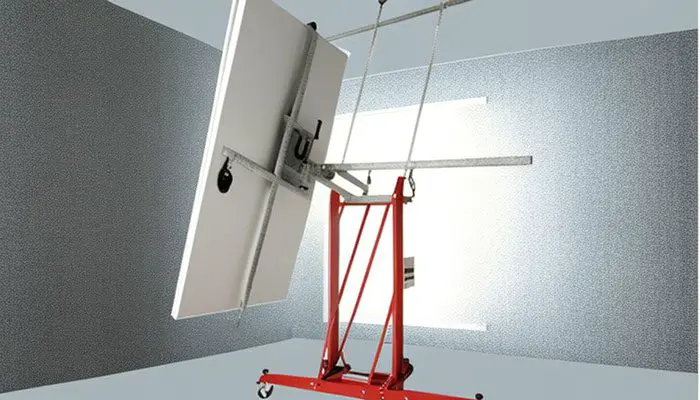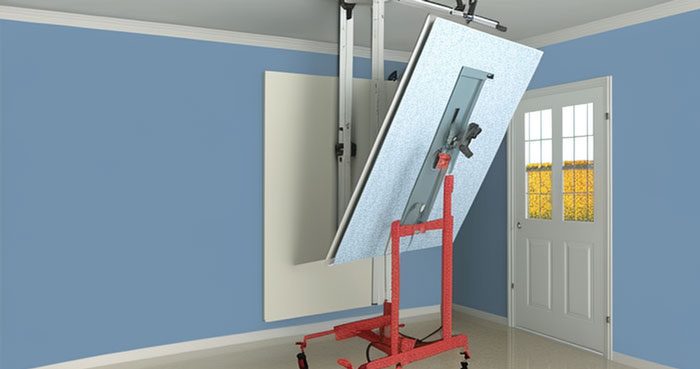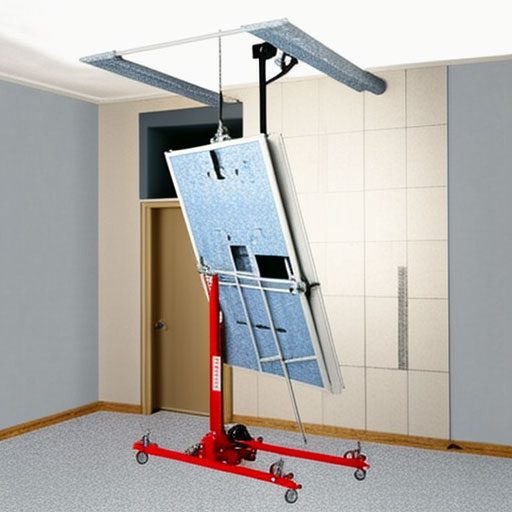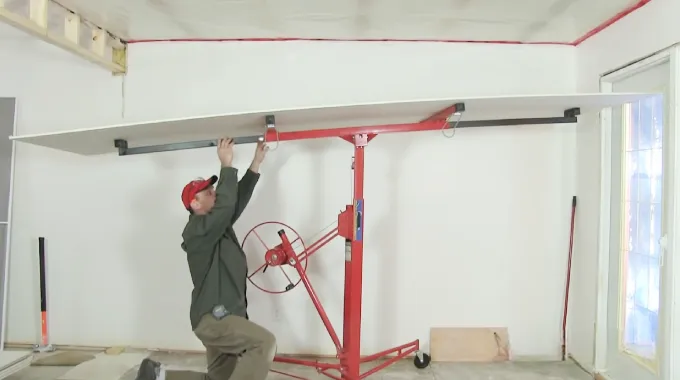Last Updated on March 5, 2023
Tired of the hassle and strain associated with lugging around heavy drywall? Drywall lifts are here to take your construction project to new heights. With a variety of features, these handy tools make transporting large items like drywall sheets less cumbersome.
Just double-check how much weight each type of drywall lift is designed to hold before using one on the worksite so that your job runs as smoothly as possible. Standard manual lifts can handle up to 150 lb/68 kg, while heavy-duty ones have a whopping 440 lb/200 kg load limit.
These lifts are designed for ultimate stability and safety through their strong metal body construction, aluminum handle, and pressure spring balance mechanisms. Not paying attention to weight capacity and other factors could lead to serious injury.
Let’s talk about how much a drywall lift panel hoist can handle and what goes into determining that amount.
How Much Weight Can a Drywall Lift Hold: Factors that Determine
When lifting a drywall panel, a number of factors must be taken into account in order to determine the maximum capacity. These factors include the body construction, handle material, pressure spring, and load-holding brake. Let’s take a look at each one to get an understanding of how they contribute to the overall lifting capacity.
1. Body Construction:

The body construction of a drywall panel lift typically consists of a pressing plate, support plate, and base made from metal. The materials used to construct these components must be strong enough to withstand repeated use and other environmental factors such as humidity and dust.
2. Aluminum or Alloy Steel Handle:
The handle material used can also influence drywall hanger lifting capacity. Most handles are made from either aluminum or alloy steel for their lightweight and durable properties. Aluminum offers a greater strength-to-weight ratio than steel, meaning it can take on more force with less effort required from the user.
Alloy steel is known for its high STR (strength). This means that heavy loads can be handled securely without breaking under pressure.
3. Pressure Spring for Balanced Loads:
Pressure springs are necessary components in order to ensure that the lift can properly balance its load while being raised or lowered. They help maintain uniform height while also preventing damage caused by uneven force distribution during lifting operations.
As such, they play an important role in determining the lifting capacity of a drywall hoist.

4. Automatic Load Holding Brake for Safety Measures:
As a safety measure, many drywall lifters come equipped with an automatic load holding brake system which is designed to keep lifted panels secure even if power is suddenly cut off or if manual control is lost due to operator error.
This ensures that any potential accidents are avoided by preventing uncontrolled drops of heavy loads during operation time frames.
Weight Loads and Capacities of Different Models

Drywall lifts are pieces of equipment that are used to install a drywall panel in areas with difficult access. They come in a wide range of sizes, and each lift can hold different amounts of weight.
1. Standard Manual Drywall Lifts:
Standard manual drywall lifts are designed to support up to 150 lbs/ 68 kg of weight due to their strong alloy steel construction. These lightweight, compact models are easy to transport and set up for use, making them ideal for home repair projects or minor renovations.
Many standard manual lifts come with adjustable arms that provide extra stability and strength when lifting heavy sheets of drywall.
2. Heavy-duty Manual Drywall Lifts:
Heavy-duty manual drywall lifts are built to withstand much heavier weights, usually up to 440 lbs/ 200 kg, depending on build quality made from aluminum construction. These lifts offer more stability and durability for larger projects, and they can handle more challenging spaces such as high ceilings or uneven surfaces.
These lifts come with telescoping arms that can be locked into place for greater safety when lifting large drywall sheets. They also have padded handles for increased comfort while carrying them around and a range of height settings that can accommodate various sizes of walls.
Advantages of Drywall Lift Tool

Drywall lift machines are extremely useful tools for construction and remodeling projects. Their ease of use, safety features, and variety in weight capacity make them an incredibly valuable asset across many industries.
1. Increased Efficiency & Time Savings:
A drywall lift machine helps streamline the process of installing large or heavy panels with minimal effort and time. It eliminates the need for multiple workers or manual labor, allowing just one person to do the job quickly and safely without overworking themselves.
It also allows a worker to be able to reach higher areas with ease, making it possible to complete tasks faster.
2. Improved Safety for Lifting and Moving Heavy Loads:
Drywall lifts are equipped with safety brakes that protect the user from potential injuries or accidents that can occur when lifting heavy loads manually. The drywall rolling lifter panel also has a sturdy base that prevents it from tipping over, even when carrying heavy objects.

The arm can easily be adjusted up and down as well as side-to-side to give easy access to all areas of a project.
3. Variety in Size and Weight Capacity:
As with many other types of machinery, drywall lift machines come in different sizes and weight capacity ratings so that they can accommodate your specific needs. For smaller projects that need smaller lifts or for larger ones that need something more powerful, there’s sure to be an option that’ll suit your requirements.
Therefore, you don’t have to worry about investing in something too big or too small for the project at hand.
Disadvantages of a Drywall Lift Tool

A drywall lift is a tool used to lift, support, and raise large pieces of drywall or plasterboard. While it can be an invaluable tool in certain circumstances, there are several drawbacks that should be taken into consideration before purchasing and using a sheetrock lift.
1. High Risk of Personal Injury due to Improper Setup:
When using a drywall lift, the risk of personal injury is high if it has not been properly set up and secured. In addition, the risks are increased due to the force needed to raise and lower heavy pieces of plasterboard.

2. Limited Lifting and Height Capacity:
Most drywall lifts have an average load capacity between 100-150 pounds, which may be too low for some projects that require larger amounts of material to be lifted at once. Additionally, they usually don’t reach very high off the ground so they are not suitable for ceilings higher than 15 feet tall.
3. More Expensive than Ladders or Scaffolding:
Sheetrock lifts tend to be more expensive than scaffolding or ladders when purchased outright due to their higher cost of production materials and labor costs associated with creating them. In addition, rental fees for these units can also be more expensive than other tools since they require more maintenance and upkeep compared to alternatives such as ladders or scaffolding.
Is a Drywall Lift Worth Buying?
Yes, a drywall lift is worth buying because it can make the job of hanging drywall much easier and faster. With this tool, a single person can do the work of two or more people.
It also comes with many safety features such as an automatic brake system that prevents injury when lifting and lowering. Additionally, it can be used for other tasks such as installing ceiling tiles or plywood panels, making it a versatile tool for any construction job.

How Do You Lift Heavy Drywall by Yourself?
Lifting heavy drywall by yourself is possible with the use of a drywall lift tool. This tool works by attaching itself to the edge of the wall board via adjustable steel pins that are operated through a winch-like device which lifts the board up into place at the desired height.
Does a Drywall Lift Fold Up?
Yes, most modern drywall lifts are designed so they will fold up against the frame when not in use for storage purposes or transportability between job sites.
The design includes two main components: a frame fitted with four adjustable legs that provide support during lifting operations and a winch assembly with folding arms located at either end.
Can You Use a Plasterboard Lift to Hang Dry Walls?
Construction crews love plasterboard lifts for hanging up drywalls with ease. Sheetrock materials don’t stand a chance against the powerful designs crafted by manufacturers, which can carry loads of around 150 pounds.
Can You Use a Sheetrock Lift for Plywood?
This handy machine is perfect for maneuvering large pieces of plywood, with four sturdy legs and a remarkable weight capacity of up to 440 pounds. It helps people put the plywood in place quickly and easily.
Improve Efficiency and Safety on Your Job with a Drywall Lift
Drywall lifts are useful tools for lifting and moving bulky drywall quickly and easily. Knowing how much weight they can hold is essential in order to ensure that no accidents or injuries occur during use.
Different factors such as the construction material, handle type, and pressure spring all play a role in determining their load capacity.
Although there can be some drawbacks to using these tools such as cost or limited capacity, their overall benefits should outweigh any issues when used properly. With the right knowledge on board, you can ensure your job gets done safely and efficiently with the help of the best drywall lift.



